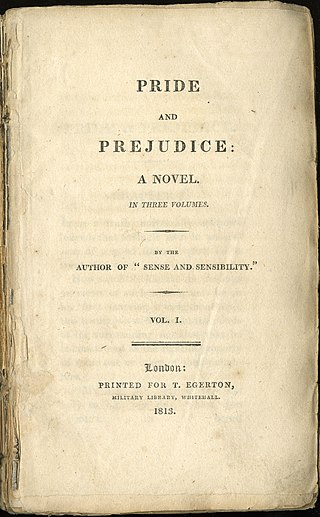
Pride and Prejudice is the second novel by English author Jane Austen, published in 1813. A novel of manners, it follows the character development of Elizabeth Bennet, the protagonist of the book, who learns about the repercussions of hasty judgments and comes to appreciate the difference between superficial goodness and actual goodness.

Pemberley is the fictional country estate owned by Fitzwilliam Darcy, the male protagonist in Jane Austen's 1813 novel Pride and Prejudice. It is located near the fictional town of Lambton, and believed by some to be based on Lyme Park, south of Disley in Cheshire.

Pride and Prejudice is a six-episode 1995 British television drama, adapted by Andrew Davies from Jane Austen's 1813 novel of the same name. Jennifer Ehle and Colin Firth starred as Elizabeth Bennet and Fitzwilliam Darcy, respectively. Produced by Sue Birtwistle and directed by Simon Langton, the serial was a BBC production with additional funding from the American A&E Network. BBC1 originally broadcast the 55-minute episodes from 24 September to 29 October 1995. The A&E Network aired the series in double episodes on three consecutive nights beginning 14 January 1996.
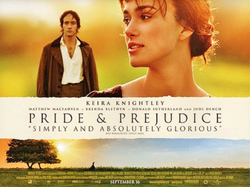
Pride & Prejudice is a 2005 historical romantic drama film directed by Joe Wright, in his feature directorial debut, and based on Jane Austen's 1813 novel. The film features five sisters from an English family of landed gentry as they deal with issues of marriage, morality, and misconceptions. Keira Knightley stars as Elizabeth Bennet, while Matthew Macfadyen plays Mr Darcy, who falls in love with her.
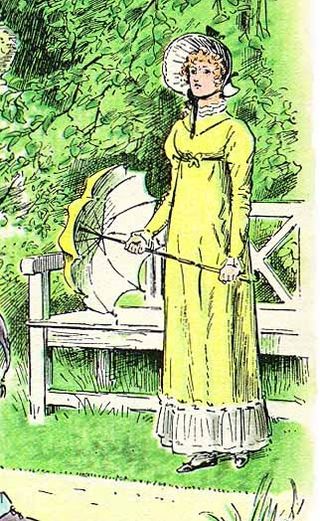
Elizabeth Bennet is the protagonist in the 1813 novel Pride and Prejudice by Jane Austen. She is often referred to as Eliza or Lizzy by her friends and family. Elizabeth is the second child in a family of five daughters. Though the circumstances of the time and environment push her to seek a marriage of convenience for economic security, Elizabeth wishes to marry for love.

Pride & Prejudice: A Latter-Day Comedy is a 2003 independent romantic comedy film directed by Andrew Black and produced by Jason Faller. The screenplay, by Anne Black, Jason Faller, and Katherine Swigert, is an adaptation of Jane Austen's 1813 novel Pride and Prejudice set in modern-day Provo, Utah. The film stars Kam Heskin as college student Elizabeth Bennet whose dreams of becoming an author supersede the cultural and societal pressures to be married. Elizabeth tries to escape the advances of several bachelors, including handsome but haughty businessman Will Darcy.
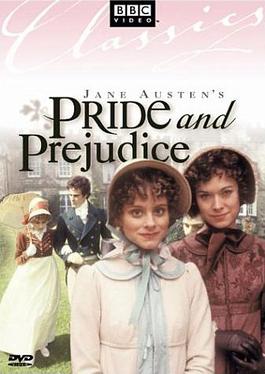
Pride and Prejudice is a 1980 television serial, adapted by British novelist Fay Weldon from Jane Austen's 1813 novel of the same name. It is a co-production of the BBC and the Australian Broadcasting Corporation. The five-episode dramatisation stars Elizabeth Garvie as Elizabeth Bennet and David Rintoul as Mr. Darcy. In the US, it was broadcast by PBS television as part of Masterpiece Theatre.

Mr. Darcy's Daughters is a 2003 novel by the English author Elizabeth Aston, published by Simon & Schuster in the United States. Set in 1818, Mr. Darcy's Daughters is written as a sequel to Jane Austen's 1813 novel Pride and Prejudice. It features the five daughters of Fitzwilliam Darcy and Elizabeth Bennet – aged 21 to 16 – as they navigate London society in the absence of their parents, who have embarked on a diplomatic post to Constantinople. In London, the sisters meet new friends and find themselves in various romantic entanglements, all while learning what is acceptable behaviour among the city's elite.
Fitzwilliam Darcy, Gentleman is the collective name given to a trilogy of historical romance novels written by Pamela Aidan. As the title suggests, they are based heavily on Jane Austen's 1813 novel Pride and Prejudice, and feature many events of the novel as seen from the perspective of Mr. Fitzwilliam Darcy, the central male character of Austen's novel.

These Three Remain is a 2005 historical romance novel by Pamela Aidan. It is the third and final novel in the Fitzwilliam Darcy, Gentleman trilogy, a series of novels examining Jane Austen's 1813 novel Pride and Prejudice from the perspective of Fitzwilliam Darcy, the central male character of that book.
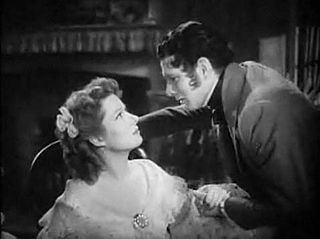
The author Jane Austen and her works have been represented in popular culture in a variety of forms.
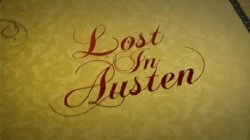
Lost in Austen is a four-part 2008 British television series for the ITV network, written by Guy Andrews as a fantasy adaptation of the 1813 novel Pride and Prejudice by Jane Austen. Amanda, a young woman living in modern London, enters the plot of the novel through a portal in her bathroom, to join the Bennet family and affect events, generally disastrously.

Edward Ferrars is a fictional character in Jane Austen's 1811 novel Sense and Sensibility. He is the elder of Fanny Dashwood's two brothers and forms an attachment to Elinor Dashwood.

Georgian society in Jane Austen's novels is the ever-present background of her work, the world in which all her characters are set. Entirely situated during the reign of George III, the novels of Austen describe their characters' everyday lives, joys, sorrows, and loves, providing insight into the period.

Jane Austen fan fiction is the collection of numerous sequels and spin-offs produced by authors who have either used the plot of Austen's original novels, or have extended them, to produce new works of fiction. Austen's posthumous popularity has inspired fan fiction that runs the gamut through numerous genres, but the most concentrated medium has remained the novel. According to Pucci and Thompson in their 2003 survey on the contemporary evolution of Jane Austen's work, at the turn of the 20th century, over one hundred sequels, rewritings, and continuations of her novels had been published.

Lady Catherine de Bourgh is a character in the 1813 novel Pride and Prejudice by Jane Austen. According to Janet Todd, Lady Catherine can be seen as a foil to the novel's protagonist Elizabeth Bennet.

The Lizzie Bennet Diaries is an American web series adapted from Jane Austen's 1813 novel Pride and Prejudice. The story is conveyed in the form of vlogs. It was created by Hank Green and Bernie Su, produced by Jenni Powell and stars Ashley Clements, Mary Kate Wiles, Laura Spencer, Julia Cho and Daniel Vincent Gordh. It premiered on a dedicated YouTube channel on April 9, 2012, and subsequently concluded when the 100th episode was posted on March 28, 2013.

Death Comes to Pemberley is a three-part British television drama based on the best-selling 2011 P. D. James novel of the same name. Her murder mystery was based on the style and characters of Jane Austen's 1813 novel Pride and Prejudice.
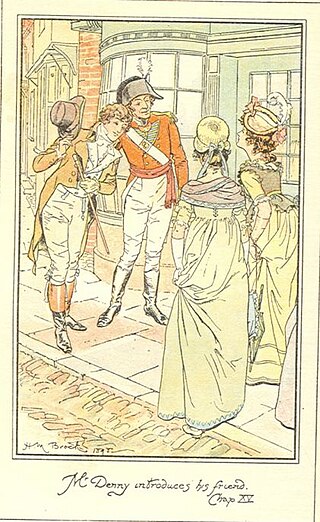
George Wickham is a fictional character created by Jane Austen who appears in her 1813 novel Pride and Prejudice. George Wickham is introduced as a militia officer who has a shared history with Mr. Darcy. Wickham's charming demeanour and his story of being badly treated by Darcy attracts the sympathy of the heroine, Elizabeth Bennet, to the point that she is warned by her aunt not to fall in love and marry him. It is revealed through the course of the story that George Wickham's true nature is that of a manipulative unprincipled layabout, a ne'er-do-well wastrel, compulsive liar and a degenerate, compulsive gambler, a seducer and a libertine, living the lifestyle of a rake. Lacking the finances to pay for his lifestyle, he gambles regularly and cons credit from tradesmen and shopkeepers and skips out on paying-up.


















